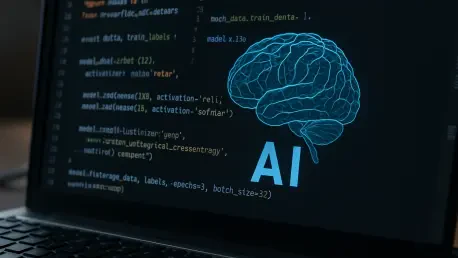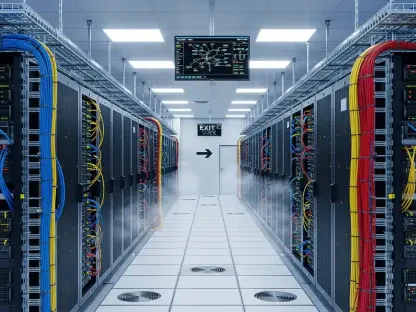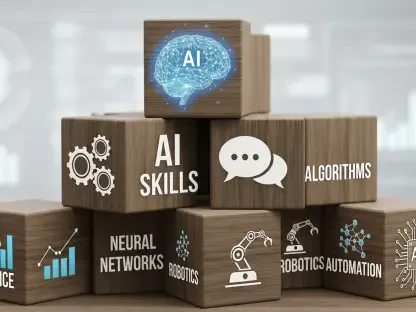The rapid integration of artificial intelligence in software development has transformed coding into a high-speed endeavor, with nearly 60% of organizations deploying code daily, raising a pressing concern about whether companies are sacrificing security for speed and piling up vulnerabilities in the process. This roundup dives into diverse perspectives from industry surveys, security professionals, and tech leaders to explore the trade-offs between AI-driven development velocity and the looming risk of security debt. The aim is to uncover whether the benefits of accelerated coding outweigh the hidden costs of unaddressed flaws, while presenting actionable insights for striking a balance.
Unpacking the AI Coding Boom: Speed as a Double-Edged Sword
The Velocity Advantage: What Surveys Reveal
Recent industry surveys paint a clear picture of AI’s impact on development timelines. Data indicates that 84% of developers have adopted or plan to adopt AI tools, leveraging them to slash project timelines significantly. This surge in productivity has redefined expectations, enabling teams to push updates and features at an unprecedented rate, often multiple times a day.
Beyond raw numbers, many tech leaders highlight how AI automates repetitive tasks, freeing developers to focus on complex problem-solving. This efficiency is seen as a competitive edge, especially in industries where being first to market can determine success. The consensus among these voices is that AI’s ability to accelerate coding is undeniable, reshaping how software is built from the ground up.
However, a lingering concern emerges from these discussions: the rush to deploy might sideline critical safeguards. Some industry observers caution that prioritizing speed could create blind spots, leaving applications exposed to risks that are harder to detect in AI-generated code. This tension sets the stage for deeper scrutiny of security implications.
Security Debt: A Growing Concern Among Professionals
Contrasting with the enthusiasm for speed, security professionals raise alarms about the mounting challenges. A striking 81% report that application security testing creates bottlenecks, struggling to keep pace with rapid deployment cycles. This lag often results in incomplete assessments, with many vulnerabilities slipping through unnoticed.
Further compounding the issue, nearly half of organizations still rely on manual security processes, ill-equipped to handle the scale and speed of AI-enhanced workflows. Statistics show that over 60% of applications go untested or only partially evaluated, amplifying the risk of breaches. Many in the field argue that this “automation gap” is a ticking time bomb for businesses chasing innovation.
A recurring theme in these discussions is the concept of security debt—unresolved flaws accumulating with each release. Several voices stress that while AI boosts output, the inability to secure code at the same rate undermines long-term stability. This perspective urges a reevaluation of how security fits into high-velocity environments.
The Risks of AI-Generated Code: Divergent Opinions
Potential for Enhanced Security or New Vulnerabilities?
On one hand, a significant portion of industry feedback—around two-thirds of surveyed individuals—believes AI can improve code security by identifying patterns and suggesting fixes that humans might overlook. This optimism stems from AI’s capacity to analyze vast datasets, potentially catching errors early in the development cycle. Proponents argue that such capabilities could redefine best practices if harnessed correctly.
On the other hand, a substantial 57% acknowledge that AI introduces unique risks, such as subtle flaws or biases in generated code that evade traditional checks. An even higher percentage of security leaders express concern over potential incidents tied to these outputs, pointing to real-world cases where undetected issues led to significant breaches. This split in opinion underscores the uncertainty surrounding AI’s reliability as a security ally.
Bridging these views, some suggest that the issue lies not in AI itself but in how it’s integrated into workflows. Without robust oversight and governance, the technology’s benefits risk being overshadowed by novel attack vectors. This balanced take calls for tailored frameworks to ensure AI’s contributions don’t come at the expense of safety.
Tool Sprawl and Alert Fatigue: A Shared Frustration
Another point of convergence among industry voices is the chaos caused by fragmented security tools. A notable 71% of professionals report being overwhelmed by noisy alerts, often riddled with false positives, which dilute focus on genuine threats. This tool sprawl hampers efficiency, creating friction in already fast-paced environments.
Many advocate for streamlined, platform-based solutions that integrate security directly into development pipelines. Such an approach, supported by over a quarter of survey respondents, could reduce alert fatigue and align security with AI’s tempo. Industry thought leaders emphasize that consolidating tools is not just a convenience but a necessity for sustainable progress.
Adding to this, broader trends reveal that remediation times for flaws have worsened by nearly 47% over recent years, starting from 2025 onward. This delay, noted across multiple reports, suggests that security struggles predate AI’s rise but are exacerbated by it. The collective insight here pushes for systemic change over patchwork fixes.
Strategies to Balance Speed and Security: Collective Wisdom
Integrating Security into AI Workflows
A common thread across various perspectives is the urgent need to embed security within AI-driven development from the outset. Rather than treating it as an afterthought, many suggest adopting real-time observability to monitor code as it’s created, catching deviations before they escalate. This proactive stance is seen as a cornerstone for managing risks.
Surveys indicate that 27% of organizations prioritize improving workflow integration, reflecting a shift toward cohesive platforms over disjointed tools. This strategy aims to minimize disruptions while ensuring that security checks keep pace with rapid deployments. Several industry players view this as a practical step to reduce accumulated vulnerabilities without sacrificing speed.
Additionally, there’s a push for upskilling teams to better understand AI outputs and their security implications. Training developers to spot potential issues in automated code could bridge the gap between innovation and safety. This human element, paired with technological solutions, forms a dual defense against mounting security debt.
Governance and Oversight: A Call for Structure
Differing slightly but complementing the above, another set of opinions focuses on the role of governance in mitigating AI-related risks. Establishing clear policies for AI tool usage, including regular audits of generated code, is frequently cited as essential. Such measures aim to create accountability in environments where speed often overshadows caution.
Regional variations in adoption also influence these discussions, with some areas showing stricter oversight while others lag in regulatory frameworks. A few voices warn that without global standards, disparities could widen, leaving some markets more exposed to threats. This angle highlights the need for collaborative efforts to define AI’s secure application in coding.
Lastly, there’s agreement that governance must evolve alongside technology. Periodic reassessment of policies ensures they remain relevant as AI capabilities expand. This adaptive approach, endorsed by many in the field, seeks to future-proof security practices against emerging challenges in automated development.
Reflecting on the Roundup: Key Takeaways and Next Steps
Looking back, this exploration revealed a complex landscape where AI’s promise of coding speed clashed with the stark reality of security debt, as echoed by diverse industry surveys and professional insights. The split between optimism for AI’s potential and concern over its risks dominated the discourse, while tool sprawl and lagging processes emerged as shared pain points. These discussions painted a picture of an industry at a crossroads, balancing innovation with the imperative of safety.
Moving forward, organizations should prioritize integrating security into every stage of AI-driven development, adopting platform-based solutions to streamline efforts and reduce noise. Investing in training and governance will further equip teams to handle the nuances of automated code, ensuring vulnerabilities are addressed proactively. Exploring emerging standards and collaborating on global frameworks can also help mitigate disparities in risk exposure, paving the way for a more secure tech ecosystem.









